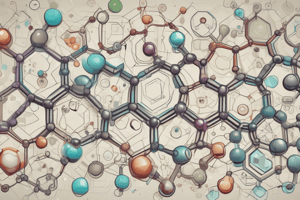Podcast
Questions and Answers
What is a characteristic of heterocyclic aromatic compounds (HACs) that is similar to benzene?
What is a characteristic of heterocyclic aromatic compounds (HACs) that is similar to benzene?
- They have a three-dimensional, cubical structure.
- They have a non-planar, irregular structure.
- They have a linear, chain-like structure.
- They have a planar, ring-shaped structure. (correct)
Which of the following heteroatoms is NOT commonly found in HACs?
Which of the following heteroatoms is NOT commonly found in HACs?
- Sulfur (S)
- Phosphorus (P) (correct)
- Nitrogen (N)
- Oxygen (O)
What is a property of HACs that contributes to their special stability?
What is a property of HACs that contributes to their special stability?
- Resonance (correct)
- Steric hindrance
- Electronegativity
- Electrostatic attraction
What is a common application of HACs in the pharmaceutical industry?
What is a common application of HACs in the pharmaceutical industry?
What is a type of reaction that HACs can undergo, depending on the heteroatom?
What is a type of reaction that HACs can undergo, depending on the heteroatom?
What is a method of synthesizing HACs?
What is a method of synthesizing HACs?
What is a feature of pyrimidines, a type of HAC?
What is a feature of pyrimidines, a type of HAC?
What is a property of HACs that affects their reactivity?
What is a property of HACs that affects their reactivity?
Flashcards are hidden until you start studying
Study Notes
Definition and Characteristics
- Heterocyclic aromatic compounds (HACs) are a class of organic compounds that contain a heteroatom (an atom other than carbon) in a cyclic ring structure.
- HACs have a planar, ring-shaped structure, similar to benzene, but with one or more heteroatoms replacing carbon atoms.
- Heteroatoms commonly found in HACs include nitrogen (N), oxygen (O), and sulfur (S).
Types of Heterocyclic Aromatic Compounds
- Pyridines: contain a nitrogen atom in the ring
- Furans: contain an oxygen atom in the ring
- Thiophenes: contain a sulfur atom in the ring
- Pyrimidines: contain two nitrogen atoms in the ring
- Pyrroles: contain a nitrogen atom in the ring, with a saturated five-membered ring
Properties
- Aromaticity: HACs exhibit aromaticity, meaning they have a planar, ring-shaped structure and exhibit special stability due to resonance.
- Electron withdrawing/donating: Heteroatoms can be electron-withdrawing or electron-donating, affecting the compound's reactivity.
- Solubility: HACs are generally more soluble in organic solvents than in water.
Importance and Applications
- Pharmaceuticals: HACs are found in many medications, such as antibiotics, antivirals, and anesthetics.
- Dyes and Pigments: HACs are used in the production of dyes, pigments, and other colorants.
- Agrochemicals: HACs are used in pesticides, herbicides, and other agrochemicals.
- Materials Science: HACs are used in the production of polymers, plastics, and other materials.
Synthesis and Reactions
- Electrophilic substitution: HACs undergo electrophilic substitution reactions, similar to benzene.
- Nucleophilic substitution: HACs can undergo nucleophilic substitution reactions, depending on the heteroatom.
- Synthesis methods: HACs can be synthesized through various methods, including ring closure, condensation, and substitution reactions.
Definition and Characteristics
- HACs are a class of organic compounds containing a heteroatom (an atom other than carbon) in a cyclic ring structure, similar to benzene.
- HACs have a planar, ring-shaped structure, with one or more heteroatoms replacing carbon atoms.
- Common heteroatoms found in HACs include nitrogen (N), oxygen (O), and sulfur (S).
Types of Heterocyclic Aromatic Compounds
- Pyridines contain a nitrogen atom in the ring.
- Furans contain an oxygen atom in the ring.
- Thiophenes contain a sulfur atom in the ring.
- Pyrimidines contain two nitrogen atoms in the ring.
- Pyrroles contain a nitrogen atom in the ring, with a saturated five-membered ring.
Properties
- HACs exhibit aromaticity, meaning they have a planar, ring-shaped structure and exhibit special stability due to resonance.
- Heteroatoms can be electron-withdrawing or electron-donating, affecting the compound's reactivity.
- HACs are generally more soluble in organic solvents than in water.
Importance and Applications
- HACs are found in many medications, such as antibiotics, antivirals, and anesthetics.
- HACs are used in the production of dyes, pigments, and other colorants.
- HACs are used in pesticides, herbicides, and other agrochemicals.
- HACs are used in the production of polymers, plastics, and other materials.
Synthesis and Reactions
- HACs undergo electrophilic substitution reactions, similar to benzene.
- HACs can undergo nucleophilic substitution reactions, depending on the heteroatom.
- HACs can be synthesized through various methods, including ring closure, condensation, and substitution reactions.
Studying That Suits You
Use AI to generate personalized quizzes and flashcards to suit your learning preferences.




